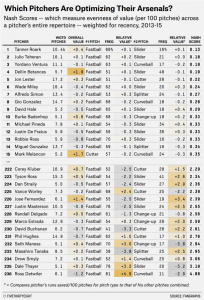Optimizing Pitch Repertoire Using Game Theory
In baseball, the battle between the pitcher and the hitter is always exciting to watch. The pitcher understands the hitter’s strengths and weaknesses, and the hitter knows the pitcher as well. Baseball is a game that is evolving rapidly due to the advancement of analytics and sabermetric tools, and in this article, a statistician uses game theory in order to analyze pitchers’ effectiveness.
Over the course of an at-bat, the pitcher tries to use an optimal mix of pitches in order to retire the batter. At the same time, the batter tries to adapt accordingly to the pitcher’s mix of pitches. This is an example of Nash Equilibrium, as it is a situation in which both parties have nothing more to gain by changing up their strategies. This works in theory, but the statistician’s goal is to figure out how close real pitchers actually are to their equilibrium. Using data from Fangraphs which tracks frequency of pitch type and potency, the statistician is able to formulate a metric called “Nash Score.” This score measures whether a pitcher is close to equilibrium, or the optimal mix of pitches. If he has a low Nash Score, he is close to equilibrium, but if he has a high Nash Score, he could benefit from varying the distribution of his pitches.
For example, let’s take a look at R.A. Dickey, a former Cy Young Award knuckleball pitcher. He throws his knuckleball 87% of the time, which is high compared to the rate at which other pitches throw their #1 pitch. However, he Nash Score is relatively high, meaning that Dickey should throw his knuckleball even more often than he already does. Other pitchers in the league, like Masahiro Tanaka, Corey Kluber, and Jose Fernandez, have even higher Nash Scores than Dickey, meaning there are even far from their equilibrium. This shows that these pitchers can also better optimize their pitching repertoire. However, what this also shows that there is little relationship between how good a pitcher is and how close he is to equilibrium, because these pitchers are already the best in the league.
This analysis relates to our Networks course as it shows a real-life example of game theory and how it can be used to optimize pitchers’ performances. Pitchers can take advantage of this analysis in order to utilize the best assortment pitches, and ideally have a better chance at getting betters out.
http://fivethirtyeight.com/features/game-theory-says-r-a-dickey-should-throw-more-knuckleballs/

